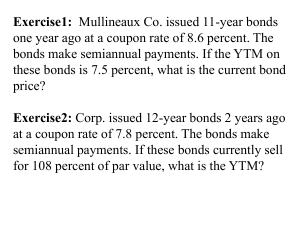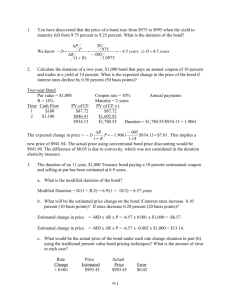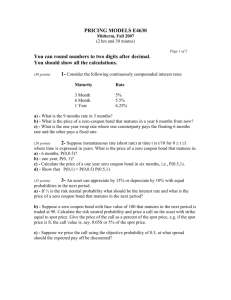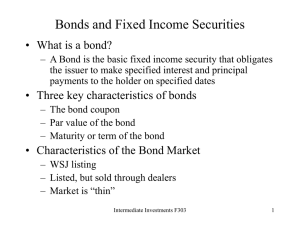P3-17 - MISWeb
advertisement
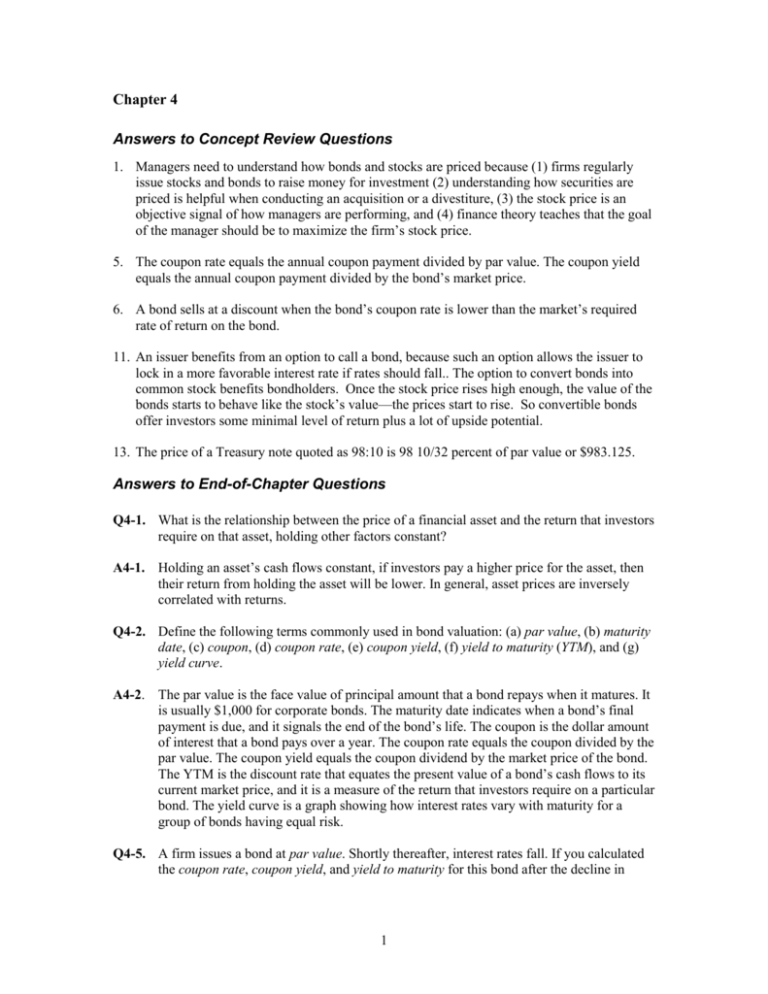
Chapter 4 Answers to Concept Review Questions 1. Managers need to understand how bonds and stocks are priced because (1) firms regularly issue stocks and bonds to raise money for investment (2) understanding how securities are priced is helpful when conducting an acquisition or a divestiture, (3) the stock price is an objective signal of how managers are performing, and (4) finance theory teaches that the goal of the manager should be to maximize the firm’s stock price. 5. The coupon rate equals the annual coupon payment divided by par value. The coupon yield equals the annual coupon payment divided by the bond’s market price. 6. A bond sells at a discount when the bond’s coupon rate is lower than the market’s required rate of return on the bond. 11. An issuer benefits from an option to call a bond, because such an option allows the issuer to lock in a more favorable interest rate if rates should fall.. The option to convert bonds into common stock benefits bondholders. Once the stock price rises high enough, the value of the bonds starts to behave like the stock’s value—the prices start to rise. So convertible bonds offer investors some minimal level of return plus a lot of upside potential. 13. The price of a Treasury note quoted as 98:10 is 98 10/32 percent of par value or $983.125. Answers to End-of-Chapter Questions Q4-1. What is the relationship between the price of a financial asset and the return that investors require on that asset, holding other factors constant? A4-1. Holding an asset’s cash flows constant, if investors pay a higher price for the asset, then their return from holding the asset will be lower. In general, asset prices are inversely correlated with returns. Q4-2. Define the following terms commonly used in bond valuation: (a) par value, (b) maturity date, (c) coupon, (d) coupon rate, (e) coupon yield, (f) yield to maturity (YTM), and (g) yield curve. A4-2. The par value is the face value of principal amount that a bond repays when it matures. It is usually $1,000 for corporate bonds. The maturity date indicates when a bond’s final payment is due, and it signals the end of the bond’s life. The coupon is the dollar amount of interest that a bond pays over a year. The coupon rate equals the coupon divided by the par value. The coupon yield equals the coupon dividend by the market price of the bond. The YTM is the discount rate that equates the present value of a bond’s cash flows to its current market price, and it is a measure of the return that investors require on a particular bond. The yield curve is a graph showing how interest rates vary with maturity for a group of bonds having equal risk. Q4-5. A firm issues a bond at par value. Shortly thereafter, interest rates fall. If you calculated the coupon rate, coupon yield, and yield to maturity for this bond after the decline in 1 interest rates, which of the three values would be highest and which would be lowest? Explain. A4-5. As rates fall the bond’s price will rise. This does not affect the coupon rate, but it will lower the coupon yield and the YTM. Because the bond now sells at a premium, there is a built-in capital loss for the investor who paid par value and holds the bond to maturity. Compensating for this loss is the fact that the bond’s coupon yield will be greater than the YTM. So in order we have: Coupon rate > coupon yield > YTM Q4-6. Twenty-five years ago, the U.S. government issued thirty-year bonds with a coupon rate of about eight percent. Five years ago, the U.S. government sold ten-year bonds with a coupon rate of about 5 percent. Suppose that the current coupon rate on newly issued five-year Treasury bonds is 2.5 percent. For an investor seeking a low-risk investment maturing in five years, do the bonds issued twenty-five years ago with a much higher coupon rate provide a more attractive return than the new five-year bonds? What about the ten-year bonds issued five years ago? A4-6. The YTM on each of these bonds would be quite similar. The bonds paying an eight percent coupon would trade at a significant premium, and the bonds paying a five percent coupon would trade at a smaller premium. The premium that an investor would have to pay to acquire either of these bonds would largely offset the higher coupon rates that they offer, leaving the YTM close to 2.5 percent. Q4-7. Describe how a bond’s interest rate risk is related to its maturity. A4-7. Generally speaking, interest rate risk increases with time to maturity. Q4-8. Explain why municipal bonds can offer lower interest rates than equally risk corporate bonds. A4-8. Interest from muni bonds is exempt from federal taxes, so the pre-tax interest rate offered by a corporate bond has to be higher than the rate on a muni bond to compensate for the higher taxes investors must pay on corporate bond interest. Q4-10. Under the expectations theory, what does the slope of the yield curve reveal about the future path of interest rates? A4-10. Under the expectations hypothesis, the slope of the yield curve indicates the direction of future interest rate movements. A positive slope indicates rising rates, and a negative slope indicates falling rates. Q4-11. If the yield curve is typically upward sloping, what would this imply about the long-term path of interest rates if the expectations theory were true? A4-11. This would imply that investors normally expect rates to rise. 2 Solutions to End-of-Chapter Problems P4-3. A $1,000 par value bond makes two interest payments each year of $45 each. What is the bond’s coupon rate? A4-3. 9% = 45(2)/1,000 P4-4. A $1,000 par value bond has a coupon rate of eight percent and a coupon yield of nine percent. What is the bond’s market price? A4-4. The annual coupon is $80. To find the price, solve 0.09 = $80/P, P = $888.89 P4-5. A bond sells for $900 and offers a coupon yield of 7.2 percent. What is the bond’s annual coupon payment? A4-5. $X/$900 = 0.072 so X = $64.8 P4-6. A bond offers a coupon rate of 5 percent. If the par value is $1,000 and the bond sells for $1,250, what is the coupon yield? A4-6. $50/$1,250 = 0.04 or 4%. P4-7. A bond makes two $45 interest payments each year. Given that the bond’s par value is $1,000 and its price is $1,050, calculate the bond’s coupon rate and coupon yield. A4-7. Coupon yield is $90/$1,050 = 0.0857 or 8.57%. Coupon rate = 9%. P4-8. Calculate the price of a five-year, $1,000 par value bond that makes semiannual payments, has a coupon rate of eight percent, and offers a yield to maturity of seven percent. Recalculate the price assuming a nine percent YTM. What general relationship does this problem illustrates? 40 40 40 1,040 .... 1,041 .58 0.07 0.07 2 0.07 3 0.07 10 (1 ) (1 ) (1 ) (1 ) 2 2 2 2 Calculator: N = 10 I = 3.5 PV = 1,041.58 PMT = 40 FV = 1000 A4-8. P 40 40 40 1,040 .... 960 .44 0.09 0.09 2 0.09 3 0.09 10 (1 ) (1 ) (1 ) (1 ) 2 2 2 2 Calculator: N = 10 I = 4.5 PV = 960.44 PMT = 40 FV = 1000 P When the coupon rate is higher than the YTM, the bond sells at a premium, but when the coupon rate is lower than the YTM, the bond sells at a discount. This problem also illustrates the general inverse relationship between bond prices and interest rates. P4-9. A $1,000 par value bond makes annual interest payment of $75. If it offers a yield to maturity of 7.5 percent, what is the price of the bond? 3 A4-9. The bond will sell at par value or $1,000 because the bonds coupon rate (75/1000 = 7.5%) is equal to its YTM. The idea here is that a bond’s market price equals par value if yield to maturity is equal to the bond’s coupon rate. P4-10. A $1,000 par value bond pays a coupon rate of 8.2 percent. The bond makes semiannual payments, and it matures in four years. If investors require a ten percent return on this investment, what is the bond’s price? A4-10. P 41 41 41 .... 1,041 $941 .83 1.05 1.05 2 1.05 3 1.05 8 Calculator: N = 8 I = 5 PV = 941.83 PMT = 42 FV = 1000 P4-11. Griswold Travel Inc. has issued six-year bonds that pay $30 in interest twice each year. The par value of these bonds is $1,000 and they offer a yield to maturity of 5.5 percent. How much are the bonds worth? 30 30 1,030 ... 1,025 .26 0.055 0.055 2 0.055 12 (1 ) (1 ) (1 ) 2 2 2 Calculator: N = 12 I = 2.75 PV = 1,025.26 PMT = 30 FV = 1000 A4-11. P P4-12. Bennifer Jewelers recently issued ten-year bonds that make annual interest payments of $50. Suppose you purchased one of these bonds at par value when it was issued. Right away market interest rates jumped, and the YTM on your bond rose to six percent. What happened to the price of your bonds? A4-12 P 50 50 50 1,050 .... $926 .40 so the price fell by $73.60. 2 3 1.06 1.06 1.06 1.0610 Calculator: N = 10 I = 6 PV = 926.40 PMT = 50 FV = 1000 P4-13. You are evaluating two very similar bonds. Both mature in four years, both have a $1,000 par value, and both pay a coupon rate of ten percent. However, one bond pays that coupon in annual installments while the other makes semiannual payments. Suppose you will require a ten percent return on either bond. Should these bonds sell at identical prices or should one be worth more than the other? Use Equations 4.2 and 4.3 and let r = 10%. What prices do you obtain for these bonds? Can you explain the apparent paradox? A4-13. Using equation 4.2, the bond that pays annual interest will sell at par value, and using equation 4.3, the semiannual bond will also sell for par value. Intuitively, the bond that makes semiannual payments should be worth more because it pays the same cash as the other bond but it pays the cash a little sooner. The fact that Equations 4.2 and 4.3 make it seem as if the two bonds will both sell at par is a result of the fact that a 10% annual discount rate is not equal to a 5% semiannual discount rate. That is, when we let r = 0.10 in Equation 4.3, we are really using an annual discount rate of 10.25%. It is only because we are applying a higher effective discount rate to the semiannual bond that it appears to be just as valuable as the bond that pays annually. 4 P4-14. A bond makes annual interest payments of $75. The bond matures in four years, has a par value of $1,000, and sells for $975.30. What is the bond’s YTM? A4-14. 975 .30 75 75 75 1,075 so r = 0.0825 or 8.25% 2 3 1 r (1 r) (1 r ) (1 r) 4 Calculator: N = 4 I = 8.25 PV = - 975.30 PMT = 75 FV = 1000 P4-15. Johanson VI Advisors issued $1,000 par value bonds a few years ago with a coupon rate of seven percent, paid semiannually. After the bonds were issued interest rates fell, and now with three years remaining before they mature, the bonds sell for $1,055.08. What YTM do these bonds offer? A4-15. 1,055 .08 35 35 35 1,035 and r =0.05 or 5% ... r r r r 1 (1 ) 2 (1 ) 3 (1 ) 6 2 2 2 2 Calculator: N = 6 I = 2.5 PV = - 1,055.08 PMT = 35 FV = 1000, r = I x 2% = 2.5 x 2% = 5% P4-16. A bond offers a six percent coupon rate and sells at par. What is the bond’s yield to maturity? A4-16. 6% P4-19. Suppose investors face a tax rate of 40 percent on interest paid by corporate bonds. Suppose AAA-rated corporate bonds currently offer yields of about seven percent. Approximately what yield would AAA-rated municipal bonds have to offer to be competitive? A4-19. The after-tax return on the corporate bonds would be 4.2% [7%(1-40%)]. Since munibond interest is tax free, municipal bonds could offer a 4.2% yield and be competitive with corporate bonds. P4-20. Investors face a tax rate of 33 percent on interest paid by corporate bonds. If municipal bonds currently offer yields of six percent, what yield would equally risky corporate bonds need to offer to be competitive? A4-20. 0.06/0.66 = 0.09 or 9%. P4-22. What is the price of a zero-coupon bond that has a par value of $1,000? The bond matures in 30 years and offers a yield to maturity of 4.5 percent. Calculate the price one year later, when the bond has 29 years left before it matures (assume the yield remains at 4.5 percent). What is the return that an investor earns if they buy the bond with 30 years remaining and sell it one year later? A4-22. 1,000/(1.045)30 = $267. 1,000/(1.045)29 = $279.02. The one-year return is therefore (279.02/267)-1 = 0.045 or 4.5%. This is just the required return on the bond. P4-23. A Treasury bond’s price is quoted as 98:11. What is the price of the bond if its par value is $1,000? 5 A4-23. 98 11/32 percent of par value or $983.44. P4-24. A corporate bond’s price is quoted as 102.312. If the bond’s par value is $1,000, what is its market price? A4-24. $1,023.12 P4-25. A one-year Treasury security offers a 4 percent yield-to-maturity. A two-year Treasury security offers a 4.25 percent YTM. According to the expectations hypothesis, what is the expected interest rate on a one-year security next year? A4-25. (1.0425)2 = (1.04)(1+r) so r = 0.045 or 4.5% 6



